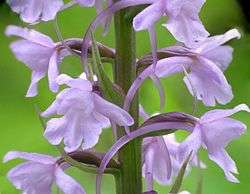Spur (botany)

Flowers of Utricularia sandersonii, displaying large floral spurs.

Gymnadenia conopsea Flowers with Nectar-filled Spur
A spur in botany is a spike, usually part of a flower.
In certain plants, part of a sepal or petal develops into an elongated hollow spike extending behind the flower, containing nectar which is sucked by long-tongued animals (insects, birds or bats). Plants with such structures include Delphinium, Aquilegia, Piperia, and some orchids, such as Gymnadenia. Spurs may be useful in species identification – for example Yadon's piperia cannot be easily distinguished from other Piperia save for the unusually short length of its spur.[1]
In tropical pitcher plants of the genus Nepenthes, the spur is a small appendage at the base of the pitcher lid.[2]
References
See also
This article is issued from Wikipedia - version of the 6/29/2016. The text is available under the Creative Commons Attribution/Share Alike but additional terms may apply for the media files.